Letters from Lodi
An insightful and objective look at viticulture and winemaking from the Lodi
Appellation and the growers and vintners behind these crafts. Told from the
perspective of multi-award winning wine journalist, Randy Caparoso.
The latest wines sourced from Mokelumne Glen Vineyards fulfill a heroic story of an exotic grape obsession
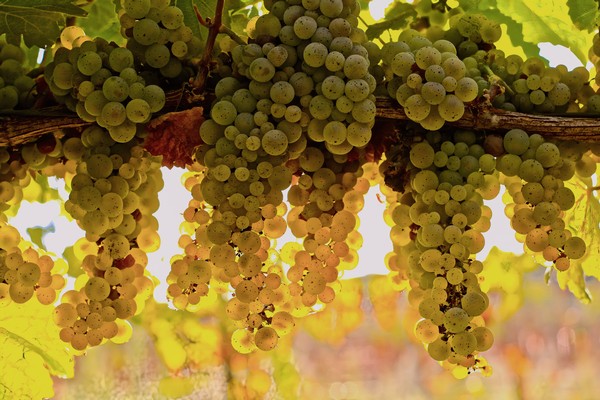
Among the multiple clones of Riesling cultivated in Lodi's Mokelumne Glen Vineyards.
The heroic tale
Let's talk about the continuing saga—and it really is a story of heroic proportions—of the Lodi appellation's Mokelumne Glen Vineyards.
First, a summary of the story up until today: It started when a serious grape bug took an extra-big bite out of Bob Koth, a Lodi educator and grape farmer, in the early 1990s when he and his wife Mary Lou Koth visited Germany where their daughter Ann-Marie was studying on a Fulbright scholarship. After tasting a number of outstanding German wines, they found a new obsession.
Soon after returning home to Lodi, the Koths removed the blocks of Flame Tokay and Zinfandel cultivated on their property, tucked into an oxbow corner of the Mokelumne River, on the east side of the appellation of that same name. Within a few years, the old plantings were replaced by what grew to be no less than over 50 different cultivars of German as well as Austrian origin.
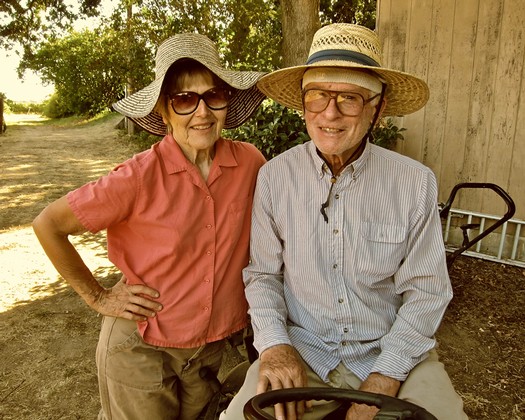
The late Mary Lou and Bob Koth, founders of Mokelumne Glen Vineyards.
This was no small task. It required digging, scratching and searching high and low to acquire cuttings. Cultivars were sourced from literally every nursery to be found, all around the world. As longtime academics, both Bob and Mary Lou were more than up to it.
Remember, though, this is Lodi, a warm climate region long thought to be the opposite of growing regions in Germany and Austria. Ah, but here's the rub: There are also fairly warm regions in Germany and Austria where many of these grapes are grown. Therefore, within a few years, at least a half-dozen of these Teutonic varieties—particularly Kerner, Riesling, Bacchus, Gewürztraminer, Dornfelder, Zweigelt, Blaufränkisch and Grüner Veltliner—seemed to flourish under the balmy sunlight and in the sandy soils of this sloping Riverbend property.
Some more (Kerner and Dornfelder) than others (Riesling and Bacchus), yet productivity proved promising enough for the Koths to expand choice grapes into small blocks and seriously consider making wine out of them.
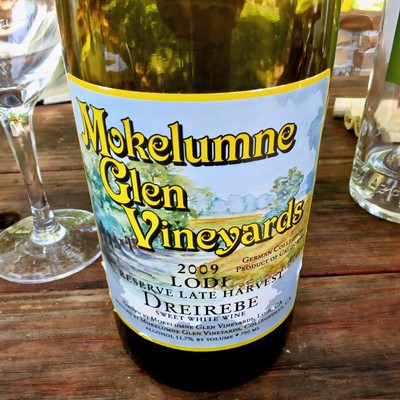
The last bottling, a 2009, of the Koth family's own Mokelumne Glen Vineyards wine, called "Dreirebe" (a blend of Riesling, Weissburgunder and Gewürztraminer).
And so, audaciously, in the early 2000s the Koths began bottling and selling wines under their own label, Mokelumne Glen Vineyards, although as anyone would have predicted, it was an uphill battle. Whoever heard of selling Germanic wine in the middle of the land of Zinfandel?
In 2010, when the family decided to execute a Bonaparte's retreat and focus strictly on grape growing rather than winemaking, surprise, surprise: They found a good amount of independent wine companies standing in line to buy their grapes!
Credit goes to producers such as Sonoma's David Ramey, Lodi's Markus Niggli and others for being among the first vintners to shine a spotlight on these grapes, considered esoteric, even outlandish, not just in Lodi, but also anywhere on the West Coast. There have been enough of these handcraft producers around to buy just about everything the vineyard grows over the past 14 years.
As it often happens with longtime couples, Bob and Mary Lou (married for 61 years) passed away within three months of each other in 2020/2021. Today the family vineyard continues to be farmed by their children, Brett and Ann-Marie Koth.

Brett Koth during a recent harvest of Mokelumne Glen Vineyards Grüner Veltliner.
The latest compelling releases
This past weekend Brett and Ann Marie put on their yearly tasting for friends and colleagues, showing off some of the more interesting of the latest wines sourced from Mokelumne Glen Vineyards. They always invite their winemaker/clients to attend, but most of them are usually unable since their wineries are as far-flung as Sonoma, Napa, Santa Barbara, L.A. and even Nevada City.
But the wines, as always, remain fascinating in their diversity, compelling in their exoticism, and most important of all, impressive in terms of sheer, unadulterated quality. These wines are important because, by and large, they fulfill the growing taste for wines that are lighter, driven more by acidity than simple fruitiness or alcohol-addled body, adding up to more puristic profiles.
It helps that, almost as a rule, the Koths' clients tend to follow a contemporary style of winemaking most likely to achieve these sensory qualities. That is, hands-off, low intervention methodology: Everything from foot treading and whole cluster, natural fermentation to neutral wood aging and minimal filtration, picking early to preserve natural acidity and keep alcohol levels low. Many wine buffs describe this approach as "natural," but that labeling has far less meaning than the actual results: Bottlings that vividly express the grapes from a specific place, in avoidance of conventional branding and industry standards.
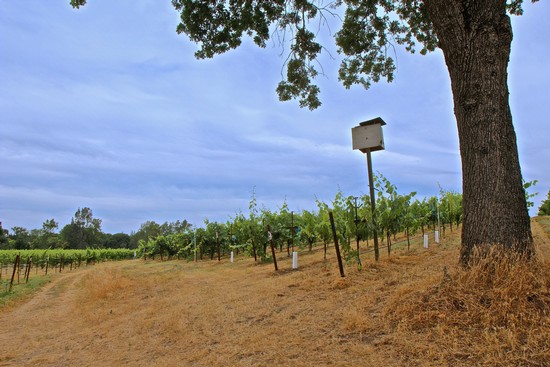
Sandy loam soil of Mokelumne Glen Vineyards, sloping down towards the curving Mokelumne River.
Some highlights tasted this past Saturday (May 4, 2024):
2023 Box Wine Co., Hills and Valley Mokelumne Glen Vineyards Lodi Kerner ($25)
Box Wine Company owners Jessica and Wesley Box's reason for existing as wine producers is, as stated on their website, "to capture the places of inspiration we come across.... forever on the hunt for remote, unique vineyard sites of merit... selecting the sites that speak to our souls, we produce small batch, blends and single vineyard wines." Hence, their enthusiasm for Mokelumne Glen's Kerner grape, a cross of Trollinger and Riesling hugely popular in Germany (the country's third most widely planted grape) as well as in Austria, Switzerland and Northern Italy, besides being cultivated in Japan and Michigan. The couple offers this wine as a single bottle or part of a 3-pack called "Freaks of the Industry."
There is nothing freakazoid, however, about this wine. It is fresh, perky and clean as a whistle (so much for the frequent complaint of low intervention detractors, that these wines are usually flawed or dirty), composed of beautifully soaring, mildly briny/minerally, fragrances suggesting lemon, peach and apricot. On the palate, the minerally profile comes across as lemony crisp, sharp as a knife, yet refreshingly lithe and easy in the way it flows across the palate.
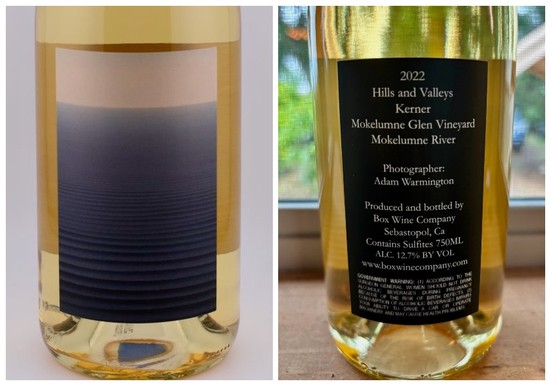
The front and back labels of Box Wine's Hills and Valley Kerner.
To extend the wine's grip on the palate, Mr. Box craftily ferments (with 100% native yeast) half the wine in an open-top fermenter with the grape skins; the other half, pressed and fermented in neutral barrels to enhance texturing. "This Kerner," says Box, "has been described as a gateway drug to skin-contact whites"—referring to the recently fashionable (yet ancient) way of fermenting white wine grapes like red wines (with skins), which often results in slightly bitter phenolic content. There is absolutely nothing bitter or rough about this wine. It positively sings; or rather, screams for "oysters" or "one-more-glass."
2021 Trail Marker Wine Co., Mokelumne Glen Vineyard Lodi Kerner ($21)
What is it that consumers of alternative style wines want, that compels them to take pains to sift through the internet, the alternative selections on store shelves or listings in natural wine bars? Many will tell you, point-blank, that they don't want a wine that tastes soft, tutti-fruity, sweet or rife with oak, which most of the domestic commercial wine market seems to hoist upon them. Most of all, they don't want predictability. They want wines that surprise them with different or unusual sensory qualities; in doing so, satisfying not just their sensory predilections, but also their intellectual principles.
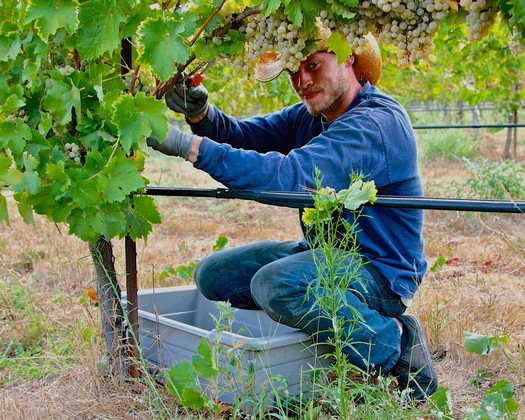
Kerner harvest in Mokelumne Glen Vineyards.
Trail Marker owners Drew Huffine and Emily Vigil have been dutifully attending to these alternative preferences since 2012. Mokelumne Glen Vineyard was a natural stepping stone because German and Austrian grapes (the predominant varietals on the market are of French origin) seemed more likely to get them there.
Per the brand's M.O., this Kerner is always harvested very early—Huffine is usually out in the vineyard by early August, picking both white and red wine grapes a good two, four or even six degrees lower in sugar (he does not fear 18° or even 16º Brix) than what is considered "normal" by industry standards—in order to achieve alcohol levels in the range of 11% to 12% ABV.
The 2021 Kerner, as it is, was finished at a "lofty" (for the brand) 12.2% ABV, giving the wine an ultra-light and tart-edged profile; although the high acidity is manifested more in the minerally, almost briny lemony taste, while the varietal fragrance retains its flowery character, even if tinged by an animal-ish (or drunken tequila night-like) essence of lime skin. The wine is fluid on the palate, yet still a little lean, tart and acid-driven, in stark contrast to the taste of mass market domestic wines.
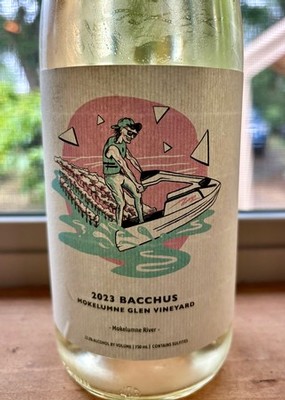
Consumer-friendly label on Friendly Noise Mokelumne Glen Vineyards Bacchus.
2023 Friendly Noise, Mokelumne Glen Vineyards Lodi Bacchus ($25)
The burgeoning alternative style wine segment has, it seems, been joined by market-driven companies that endeavor to bridge the gap between esoterica and something of a sensory "friendliness," manifested in equally affable packaging (re the happy "jet skiing" cartoon on this label).
On their website, Friendly Noise describes itself as an "independent wine company," evidently self-funded, with the goal of producing "a truly honest beverage" that is stylistically "clean tasting, have no strong oak presence, and are generally on the dry and fruity side of things."
It is almost masochistic, however, for this sincere-sounding club to choose Bacchus as a medium because this particular grape, of all of Mokelumne Glen's plantings, is probably the most mercurial and most difficult to ripen (October is "early" for this cultivar), yielding wines of the most elusive character (some years, grown in Lodi, Bacchus-based whites are herbaceous and underripe, other years sweet toned and honeyed).
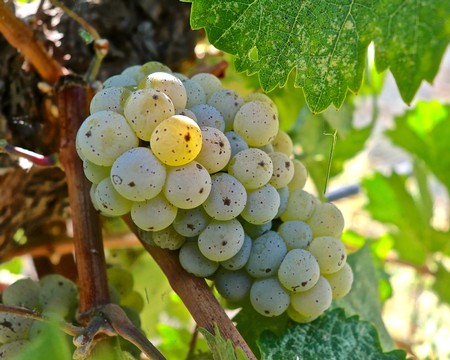
Close-up of the extremely rare (for California) Bacchus grape.
Yet in almost every vintage, the Bacchus grape—a 1933 Germanic crossing of Müller-Thurgau and (Silvaner x Riesling)—produces a bone dry white wine that is vivid in the nose and meaty textured on the palate; attaining these qualities easily enough, completely without the props of oak barrels or high intervention techniques (such as acid adjustment, enzymes of non-native yeast).
The Friendly Noise Bacchus stands on its own bare naked, somewhat restrained self in this 2023 bottling: Effusive with fresh thyme-like herbiness, a dribble of honey, faint suggestion of lemon on cantaloupe; coming across with more mineral than "fruit" impressions on the palate, obdurate yet silky in its light feeling medium body (13.5% ABV). Laudably, a cleanly, solidly executed wine, despite the challenge and peculiarity of the grape itself.
2023 Haarmeyer Wine Cellars, Mokelumne Glen Vineyards Victor Weisser, Lodi Gemischter Satz ($28)
Haarmeyer's Victor Weisser, perhaps more than the two Kerners and Bacchus, qualifies as an industry "freak." It is made from no less than 52 of the grapes planted in Mokelumne Glen, both red and white varieties—from Riesling, Kerner and Gewürztraminer to Dornfelder, Zweigelt, Blaufränkisch and Spätburguner (a.k.a., Pinot noir)—picked all together on one morning, basket pressed, co-fermented to dryness with native yeast, and finished in a neutral large format barrel (5 months before bottling).

Large format neutral oak barrels utilized by West Sacramento's Haarmeyer Wine Cellars.
Tasting this pale gold tinted wine is, indeed, like hearing a thousand voices at one time, like the host of ancestors in the heads of Reverend Mothers in "Dune." What stands out in the nose are honeyed and spiced floral scents somewhat akin to dianthus (vanillin clove/pepper) and, beneath those breaths, a fresh bag of potpourri laced with tobacco leather and dried citrus, underscored by suggestions of honeydew or cantaloupe sprinkled with salt.
On the palate, the multifaceted sensations are bone dry and feathery light (just 12.05% ABV); starting off silky and mildly viscous, then becoming meaty, almost toothsome in a finely textured yet grippy feel—all those "voices" of white and black skinned grapes tussling with one other—before finishing off with tart/oily twists of lemon peel.
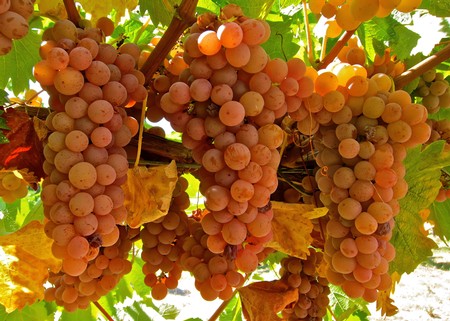
Among the over 50 German and Austrian grapes grown in Mokelumne Glen Vineyards: the brilliantly pink, exotically perfumed Schõnburger, a cross of Pinot noir and (Chasselas x Muscat Hamburg).
All told, a wine that is neither a white, red, pink nor "orange" wine. It is certainly not suggestive of any one grape; even though, at the moment, you can say the lemon and perfume of Riesling sings a little louder, and the exotic spice and mildly phenolic texturing of Gewũrztraminer (or is it the pink colored Schönburger?) grapples for attention—although the textural qualities can undoubtedly be attributed just as much to the black skinned grapes in the mix.
What the Victor Weisser is, above all, is a wine that speaks loudly of the place; the bright sun that kisses the fruit skins, the daily Delta breeze rustling through the leaves and the silky-sandy soil that cradles the grapevine roots like a proverbial Mother Earth. Ultimately it tastes like Lodi's Mokelumne Glen, as much in terms of its originality and intellectual pursuit as its sensory disposition.
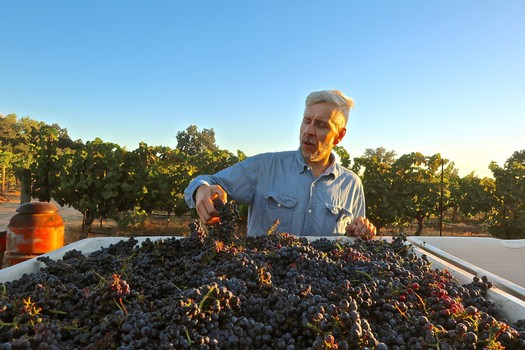
Trail Marker's Drew Huffine harvesting 2022 Zweigelt early on (August 9) in Mokelumne Glen Vineyards.
2022 Trail Marker Wine Co., Mokelumne Glen Vineyard, Kid Sister Lodi Zweigelt ($30)
Aficionados of Austrian wine know know this Austrian crossing (St. Laurent x Bläufransch) well, which produces good, dry reds ranging from moderately weighted and fruit driven to full bodied and deeply extracted in color, tannin, flavor and sometimes oak.
Consistently, at least in the hands of Trail Marker, this Lodi vineyard's Zweigelt falls on the lighter side (the 2022 is just 12.6% ABV), while retaining seemingly all the color and flavor in the world: Intensely fragrant, fresh red berry/cherry/cranberry aromas, notably zesty with acidity in its light-medium body, and silky smooth despite a firming (if ultimately moderate) tannin feel.
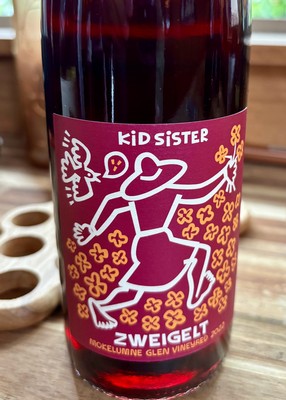
While the colorful, whimsical label suggests that this bottling should be appreciated with a good dose of ease and levity, it belies the actual depth and intensity of the wine itself. The important part is that it's a very good, if unusual, red wine, with a laudable sense of restraint.
2021 Sunce Winery, Mokelumne Glen Vineyards Lodi Dornfelder ($28)
This Russian River Valley, Sonoma-based winery produces such a wide range of red wines—its current online order form lists more than 40 different wines made from over 15 different grapes—it comes at almost no surprise that it dabbles in Mokelumne Glen Vineyards-grown Dornfelder. What don't they make?
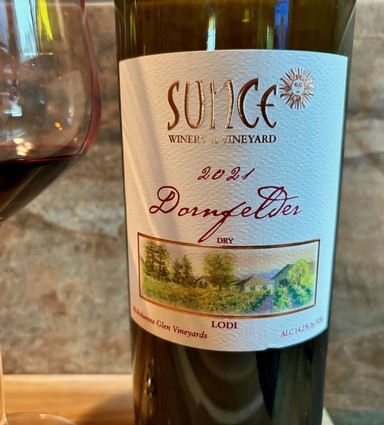
This grape is still another German crossing, devised in 1955 from the Helfensteiner and Heroldrebe grapes, which are in themselves crossings. The original goal was to produce a high production red wine variety capable of deep color and high phenolic content. The grape has flourished in Germany (it is the second most widely planted red wine variety in the country), generally producing flavorful wines of intense color yet easy drinking character.
In Lodi, the grape has turned out to be almost Frankenstein-like—like a science experiment gone amuck, transformed into something far different than what is found in Germany. The pigmentation of Mokelumne Glen Dornfelders has been more black than ruby (you wouldn't want to spill a drop on a white table cloth); the tannin levels monolithic, and the flavors as deep as a proverbial wishing well.

Mokelumne Glen Vineyards Dornfelder on a harvest morning.
Sunce's 2021 iteration is true to form, even if executed with enough restraint (not surprising, since Sunce is, at heart, a Pinot Noir specialist) to let the varietal stand by its lonesome: An inky purplish ruby in color, intensely fragrant in the plummy/black cherry/blackberry aroma typical of the varietal, and strappingly full (14.2% ABV) and musclebound, with chunky, roasted meat qualities on the palate.
Unlike what you find in typical California red wines, however, there is a higher level of natural acidity (as opposed to the sharpness of added acid) at play; giving the flavors a bright, zesty lift, and the body a compact and restrained feel rather than one that is massive or blundering.
Texturally, though, not a red wine for the faint at heart; yet in terms of the fruit profile and terroir-related definitions, true to this unique varietal, and true to this special place tucked along the Mokelumne River.
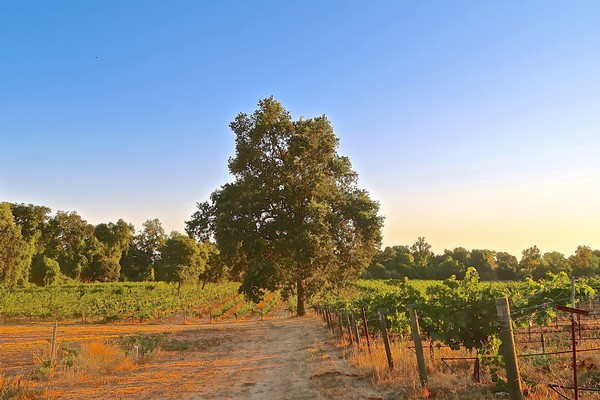
Mokelumne Glen Vineyards tucked up against the treeline of the Mokelumne River on a July morning.